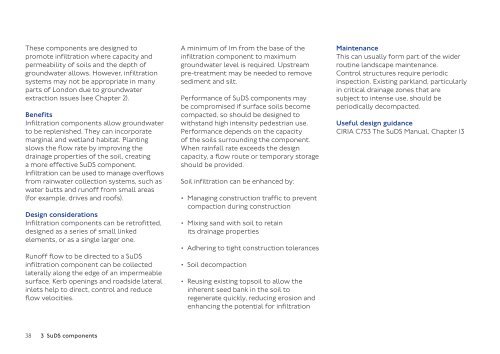SuDS in London - a guide
sustainable-urban-drainage-november-2016
sustainable-urban-drainage-november-2016
You also want an ePaper? Increase the reach of your titles
YUMPU automatically turns print PDFs into web optimized ePapers that Google loves.
These components are designed to<br />
promote <strong>in</strong>filtration where capacity and<br />
permeability of soils and the depth of<br />
groundwater allows. However, <strong>in</strong>filtration<br />
systems may not be appropriate <strong>in</strong> many<br />
parts of <strong>London</strong> due to groundwater<br />
extraction issues (see Chapter 2).<br />
Benefits<br />
Infiltration components allow groundwater<br />
to be replenished. They can <strong>in</strong>corporate<br />
marg<strong>in</strong>al and wetland habitat. Plant<strong>in</strong>g<br />
slows the flow rate by improv<strong>in</strong>g the<br />
dra<strong>in</strong>age properties of the soil, creat<strong>in</strong>g<br />
a more effective <strong>SuDS</strong> component.<br />
Infiltration can be used to manage overflows<br />
from ra<strong>in</strong>water collection systems, such as<br />
water butts and runoff from small areas<br />
(for example, drives and roofs).<br />
Design considerations<br />
Infiltration components can be retrofitted,<br />
designed as a series of small l<strong>in</strong>ked<br />
elements, or as a s<strong>in</strong>gle larger one.<br />
Runoff flow to be directed to a <strong>SuDS</strong><br />
<strong>in</strong>filtration component can be collected<br />
laterally along the edge of an impermeable<br />
surface. Kerb open<strong>in</strong>gs and roadside lateral<br />
<strong>in</strong>lets help to direct, control and reduce<br />
flow velocities.<br />
A m<strong>in</strong>imum of 1m from the base of the<br />
<strong>in</strong>filtration component to maximum<br />
groundwater level is required. Upstream<br />
pre-treatment may be needed to remove<br />
sediment and silt.<br />
Performance of <strong>SuDS</strong> components may<br />
be compromised if surface soils become<br />
compacted, so should be designed to<br />
withstand high <strong>in</strong>tensity pedestrian use.<br />
Performance depends on the capacity<br />
of the soils surround<strong>in</strong>g the component.<br />
When ra<strong>in</strong>fall rate exceeds the design<br />
capacity, a flow route or temporary storage<br />
should be provided.<br />
Soil <strong>in</strong>filtration can be enhanced by:<br />
• Manag<strong>in</strong>g construction traffic to prevent<br />
compaction dur<strong>in</strong>g construction<br />
• Mix<strong>in</strong>g sand with soil to reta<strong>in</strong><br />
its dra<strong>in</strong>age properties<br />
• Adher<strong>in</strong>g to tight construction tolerances<br />
• Soil decompaction<br />
• Reus<strong>in</strong>g exist<strong>in</strong>g topsoil to allow the<br />
<strong>in</strong>herent seed bank <strong>in</strong> the soil to<br />
regenerate quickly, reduc<strong>in</strong>g erosion and<br />
enhanc<strong>in</strong>g the potential for <strong>in</strong>filtration<br />
Ma<strong>in</strong>tenance<br />
This can usually form part of the wider<br />
rout<strong>in</strong>e landscape ma<strong>in</strong>tenance.<br />
Control structures require periodic<br />
<strong>in</strong>spection. Exist<strong>in</strong>g parkland, particularly<br />
<strong>in</strong> critical dra<strong>in</strong>age zones that are<br />
subject to <strong>in</strong>tense use, should be<br />
periodically decompacted.<br />
Useful design guidance<br />
CIRIA C753 The <strong>SuDS</strong> Manual, Chapter 13<br />
38 3 <strong>SuDS</strong> components


